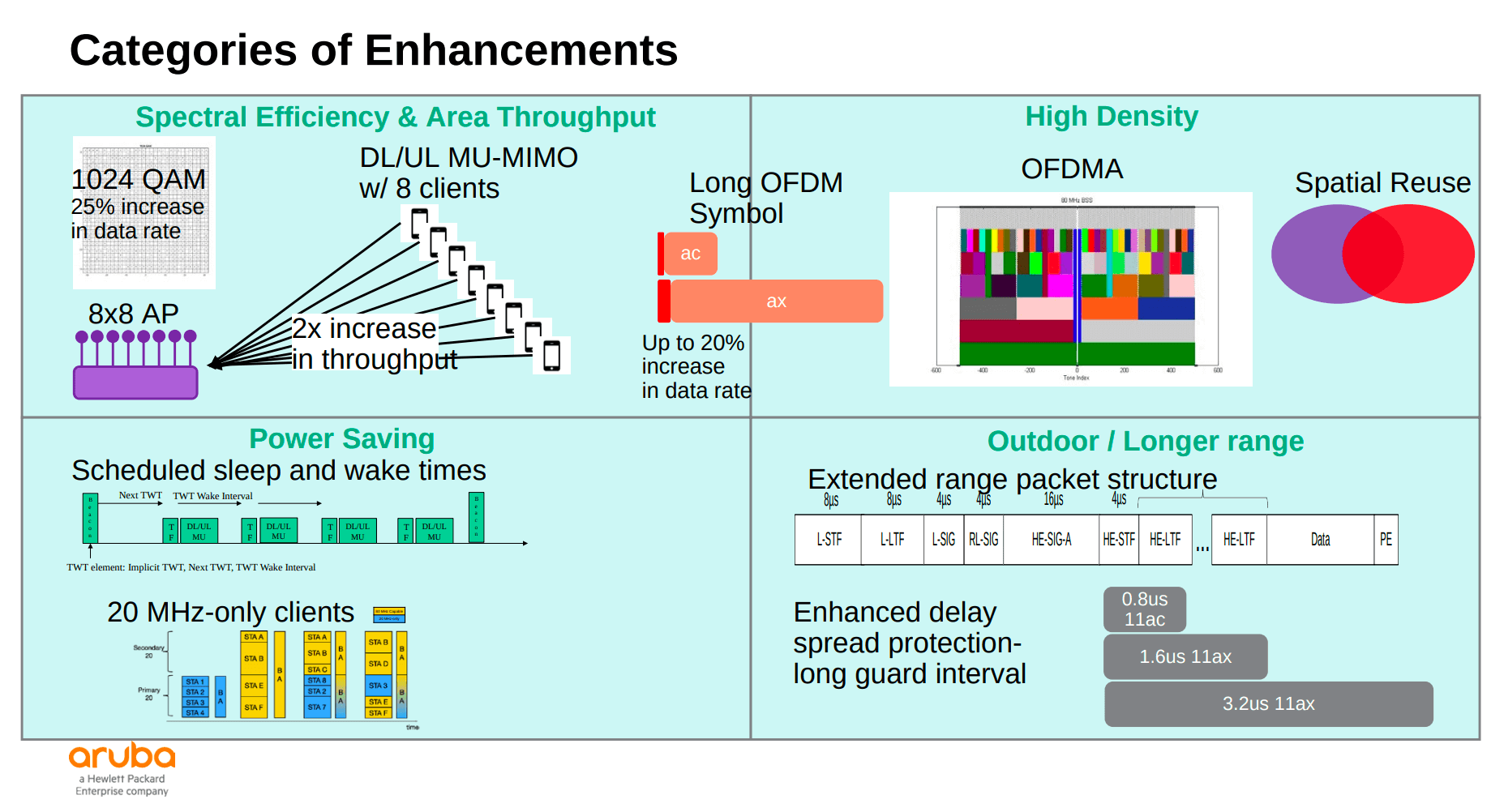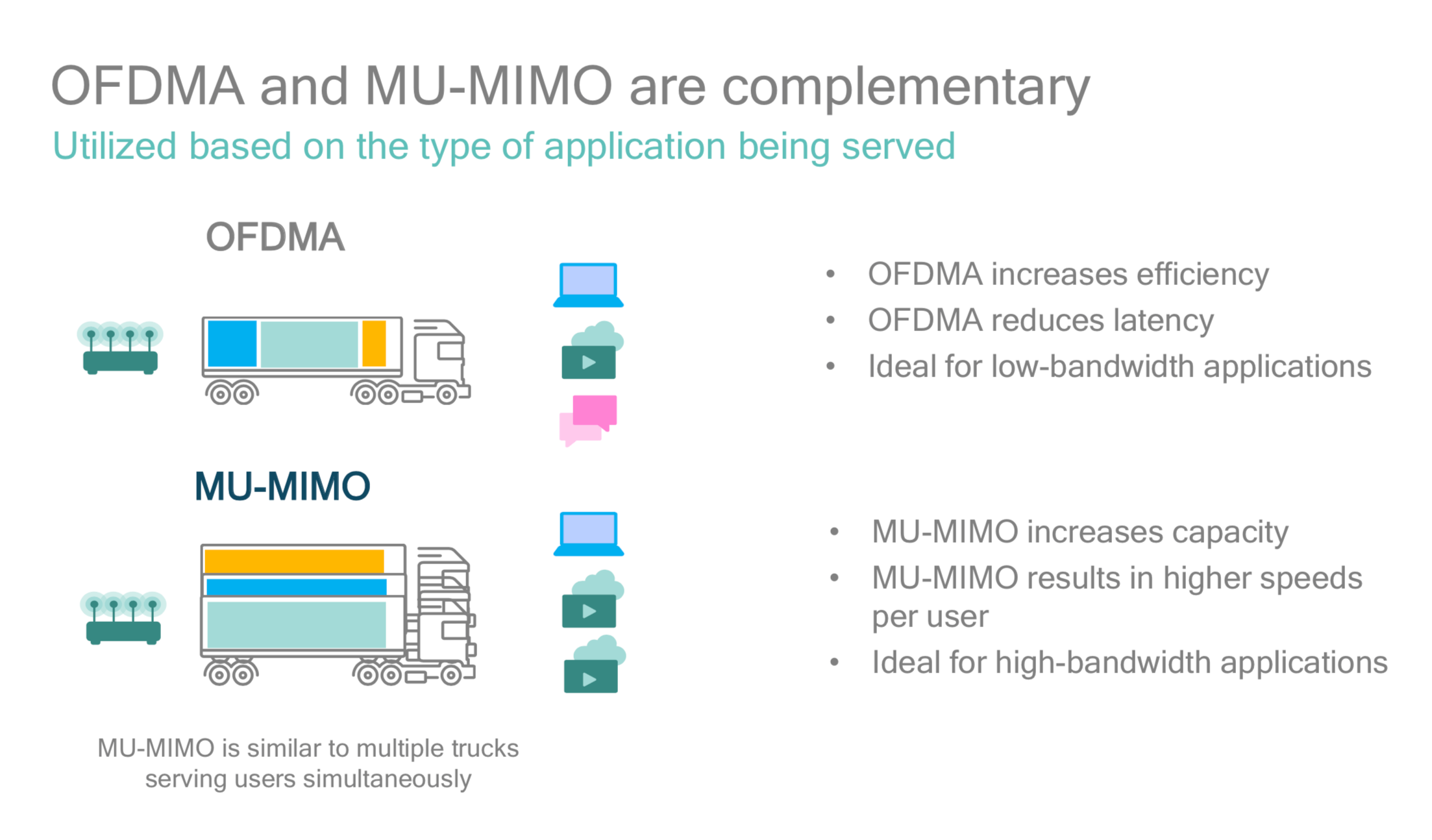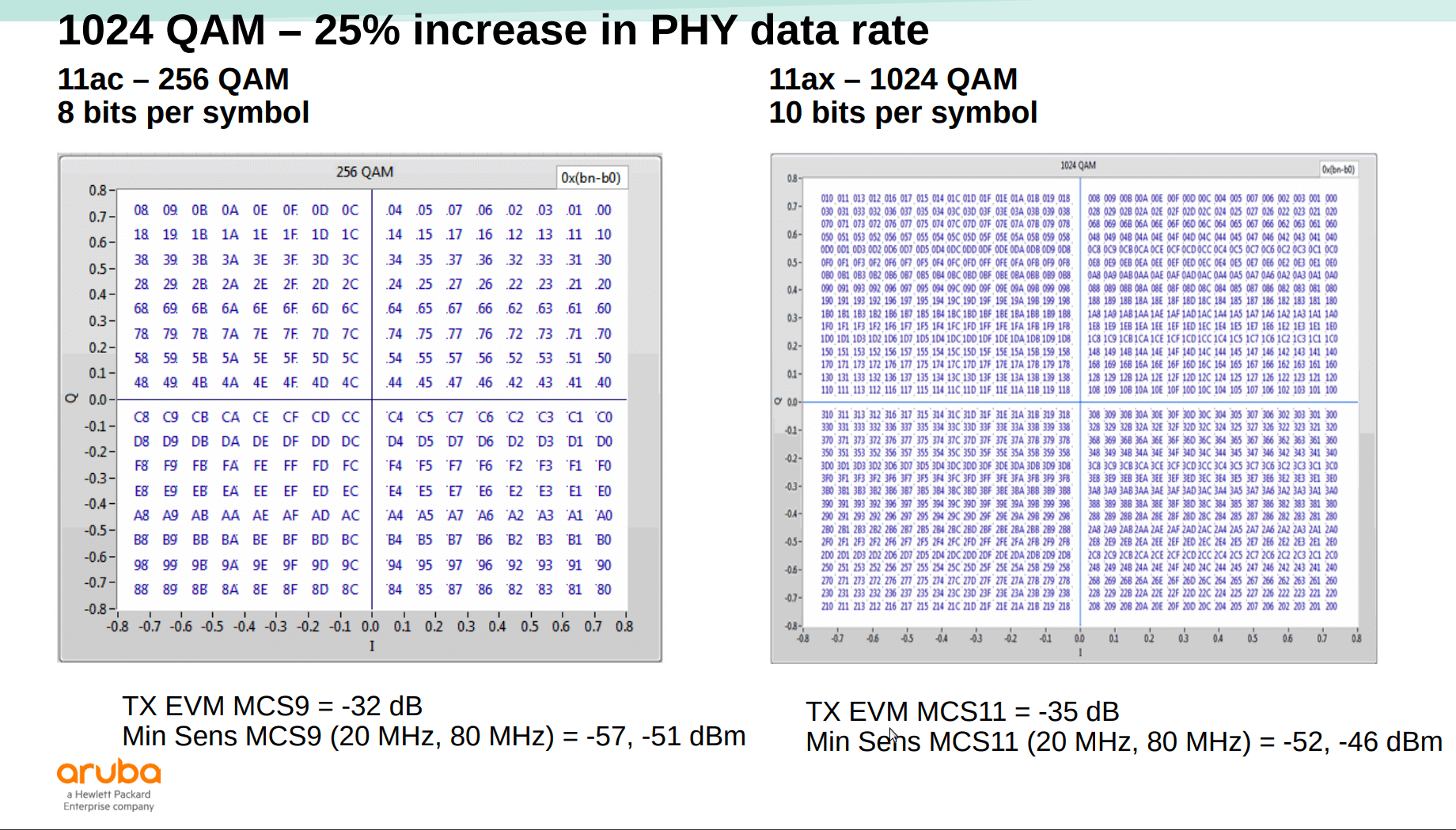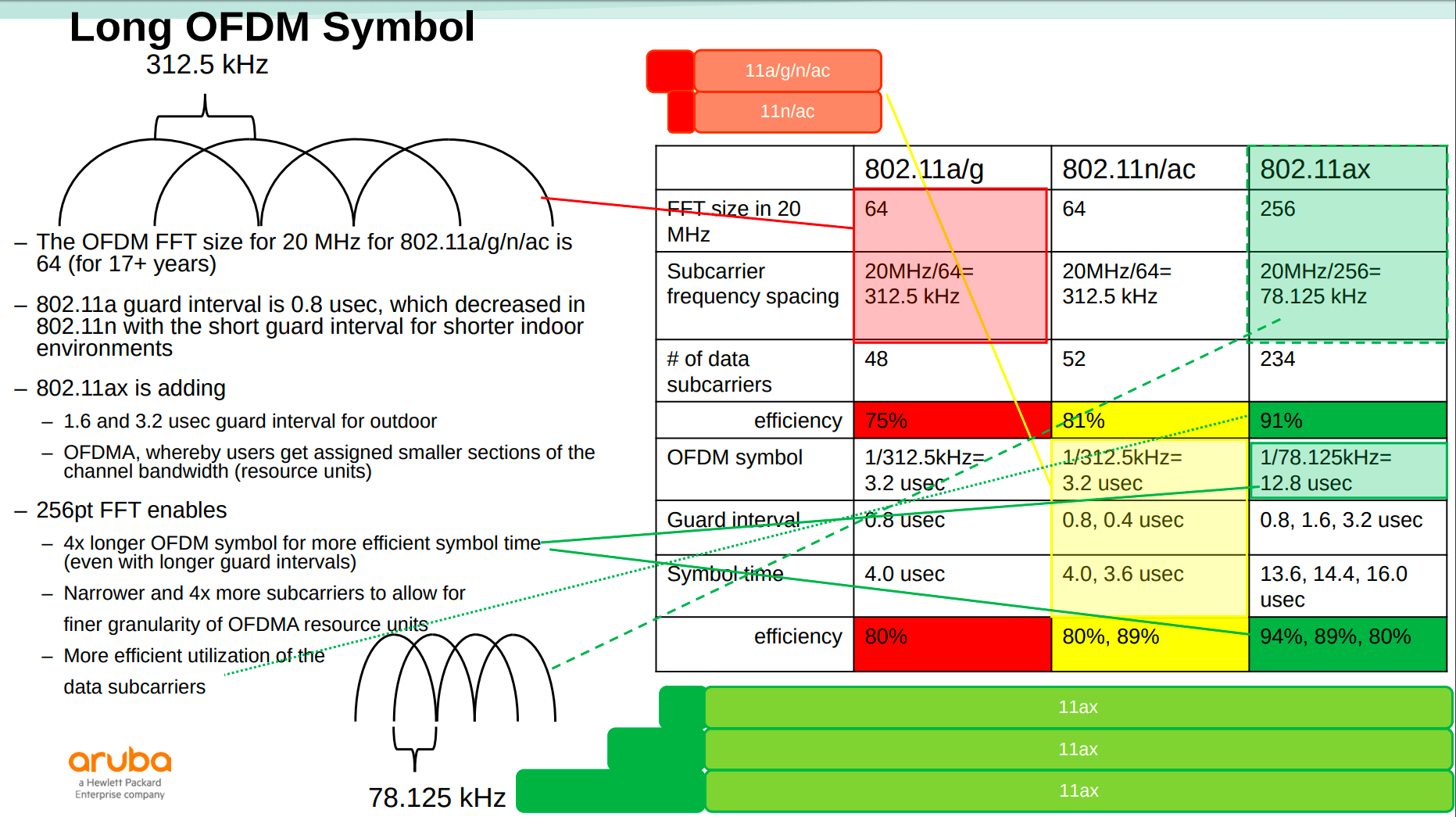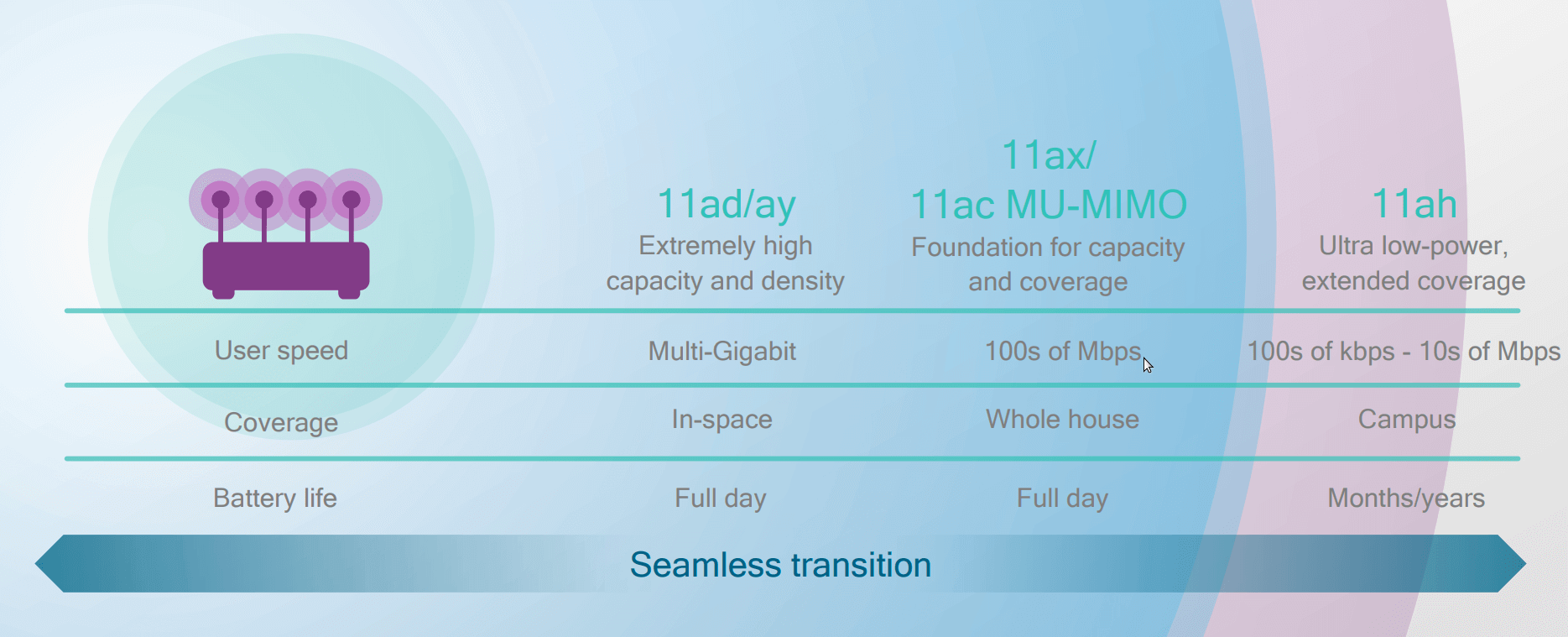The latest generation of Wi-Fi, known as Wi-Fi 6, brings with it some significant performance improvements that aim to address limitations in older generations. While plenty of routers and clients are already available with chips using the 802.11ax certification, Wi-Fi 6 is just beginning its rollout. It will become part of the official IEEE specification in September 2020. This is ushering in a wave of updated devices touting new wireless capabilities that will contribute toward next-generation networks with more speed and less congestion.
Before we get too far, it's important to understand that 802.11ax, also known as "high-efficiency wireless," is the same thing as Wi-Fi 6. It's just easier to say Wi-Fi 6 than 802.11ax.
This is a new naming standard set by the Wi-Fi Alliance, with previous generations now being known as Wi-Fi 5 (802.11ac) and Wi-Fi 4 (802.11n). This labeling convention is expected to appear on devices as shown below.
Technically, Wi-Fi 6 has a single-user data rate that is 37% faster than 802.11ac, but what's more significant is that the updated specification will offer four times the throughput per user in crowded environments, as well as better power efficiency which should translate to a boost in device battery life.
To achieve those improvements, 802.11ax implements a variety of changes including several multi-user technologies which have been borrowed from the cellular industry - namely MU-MIMO and OFDMA - techniques that greatly improve capacity and performance by enabling more simultaneous connections and a more thorough use of spectrum.
Home users who upgrade their hardware can look forward to some improvements from these technologies, especially over time as the number of devices per household increases - some estimates suggest there will be as many as 50 nodes per home by 2022.
While Wi-Fi 6 isn't designed to boost download speeds significantly, the new features will really shine as device count in an area increases. It has a more nuanced approach that is expected to bring move benefits over time. This will ultimately aid in laying a foundation for the number of nodes expected on upcoming smart infrastructure (e.g. Internet of Things devices). Along with addressing overlapping coverage from the sheer number of devices and network deployments emerging as IoT rolls out, Wi-Fi 6 will be equipped to handle the ever-increasing demand for faster multi-user data rates.
Overall, Wi-Fi 6 builds on 802.11ac with more than 50 updated features originally proposed, though not all of them are included in the finalized specification.
Here's some of Wi-Fi 6's main benefits:
- More overall bandwidth per user for ultra-HD and virtual reality streaming
- Support for more simultaneous streams of data with increased throughput
- More total spectrum (2.4GHz and 5GHz, eventually bands in 1GHz and 6GHz)
- Said spectrum split into more channels to enable more routes for communication
- Packets contain more data and networks can handle different data streams at once
- Improved performance (as much as 4x) at the maximum range of an access point
- Better performance/robustness in outdoor and multi-path (cluttered) environments
- Ability to offload wireless traffic from cellular networks where reception is poor
802.11n vs. 802.11ac vs. 802.11ax
| 802.11n (Wi-Fi 4) | 802.11ac Wave 2 (Wi-Fi 5) | 802.11ax (Wi-Fi 6) | |
| Released | 2009 | 2013 | 2019 |
| Bands | 2.4GHz & 5GHz | 5GHz |
2.4GHz & 5GHz, spanning to 1GHz - 6GHz eventually |
| Channel Bandwidth |
20MHz, 40MHz (40MHz optional) |
20MHz, 40MHz, 80MHz, 80+80MHz & 160MHz (40MHz support made mandatory) |
20MHz/40MHz @ 2.4GHz, 80MHz, 80+80MHz & 160MHz @ 5GHz |
|
Subcarrier Spacing |
312.5kHz |
312.5kHz |
78.125 kHz |
|
OFDM Symbol Duration |
3.6us (short guard interval) 4us (long guard interval) |
3.2us (0.4/0.8us cyclic prefix) |
12.8us (0.8/1.6/3.2us cyclic prefix) |
|
Highest Modulation |
64-QAM |
256-QAM |
1024-QAM |
|
Data Rates |
Ranging from 54Mb/s to 600Mb/s (max of 4 spatial streams) |
433Mb/s (80MHz, 1 spatial stream) 6933Mb/s (160MHz, 8 spatial stream) |
600Mb/s (80MHz, 1 spatial stream) 9607.8Mb/s (160MHz, 8 spatial stream) |
|
Channel Configuration |
Single User MIMO & OFDM |
Single User MIMO & OFDM Wave 1, Multi User MIMO & OFDM Wave 2 |
Multi User MIMO & OFDMA |
Released in 2013, 802.11ac (now also known as Wi-Fi 5) was standardized in 2013. While this specification is largely adequate for today's typical home usage, it only uses bands in the 5GHz spectrum and lacks the level of multi-user technologies that will support a growing number of devices connected at once.
As a point of reference for the changes coming in Wi-Fi 6, here is what 802.11ac (Wi-Fi 5) expanded on 802.11n (Wi-Fi 4):
- Wider channels (80MHz or 160MHz versus a max of 40MHz in the 5GHz band)
- Eight spatial streams instead of four (spatial streams illustrated)
- 256-QAM versus 64-QAM modulation (transmits more bits per QAM symbol)
- Multi-User MIMO (MU-MIMO) on 802.11ac Wave 2, enabling four downlink connections at once instead of only one on Single-User MIMO (still 1x1 on uplink)
The specification is backward compatible with previous standards, incorporating both 2.4GHz and 5GHz along with eventually expanding that spectrum to include bands in 1GHz and 6GHz when they become available.
Perhaps more noteworthy than the inclusion of this additional spectrum are the technologies that will put this bandwidth to use. With more spectrum available, Wi-Fi 6 can split the bandwidth into narrower (more) sub-channels, creating more avenues for clients and access points to communicate along with enabling support for additional devices on any given network. In the older 802.11n, you could essentially only have 3 separate channels going at once since there was so much overlap. This makes crowded areas like apartments a mess since everyone's router is stepping on each others. 802.11ac added extra space in the 5GHz band, but 802.11ax does a much better job of handling this.
Another area to look at is multi-device performance on a single network. This is known as Multiple-Input Multiple-Output and allows a single device to communicate over multiple channels at once. It's basically like having several wireless adapters connected to the same network. The extension of this on the access point end is called MU-MIMO or Multi-User MIMO. As the name suggests, it allows an access point to connect to multiple users at once through MIMO.
While Wi-Fi 5 can serve four users on downstream at once courtesy of MU-MIMO - a considerable improvement over the single-user MIMO on Wi-Fi 4 - this feature is not a requirement and was only added in newer 802.11ac devices. On paper, 802.11ax will increase that to eight users on both up and downlink, with the potential to deliver four simultaneous streams to a single client.
However, uplink MU-MIMO isn't likely to see much use. Few if any current devices can benefit from four spatial streams, much less the eight supported on Wi-Fi 6, as most existing MU-MIMO-equipped smartphones and laptops only have 2x2:2 or 3x3:3 MIMO radios.
This number formatting (AxB:C) is used to demonstrate the maximum amount of transmit antennas (A), the maximum amount of receive antennas (B) and the maximum amount of spatial data streams (C) supported by a MIMO radio. While a Wi-Fi device must support MU-MIMO to directly benefit from that technology, hardware without MU-MIMO chips should indirectly benefit from the additional air time available on MU-MIMO-enabled access points.
To help you visualize those technologies, instead of one clerk serving a single line of customers individually, the combination of MU-MIMO and OFDMA can be equated to having many clerks and many lines, with each clerk capable of serving multiple customers at once. Further, 802.11ax informs clients more clearly when a router is available instead of having them contend for access.
Although Wi-Fi 6's overall data rates and channel widths are similar to Wi-Fi 5, dozens of technologies have been implemented to the updated specification that should significantly improve the efficiency and throughput of future Wi-Fi networks, which could potentially serve dozens of devices on a single channel with speeds of several gigs a second. We'll go over some of them now.
OFDMA - Wi-Fi 6 also introduces support for up and downlink "Orthogonal Frequency-Division Multiple Access" (OFDMA), a modulation scheme that is equated to a multi-user version of OFDM (the spec on 802.11ac/n). OFDMA will reduce latency, boost capacity and improve efficiency by allowing as many as 30 users at once to share a channel. This is not to be confused with Orthogonal Frequency-Division Multiplexing (OFDM) which is something different.
OFDMA allows for better resource unit allocation in a given bandwidth. Incorporated on Wi-Fi 6 so more clients (as many as 30) can share the same channel instead of waiting, while also improving efficiency by combining different traffic types. OFDMA is compared as a multi-user version of OFDM.
To oversimplify, OFDM splits up a channel into several subcarriers which allows multiple parallel data streams. However, each user must use their full subcarrier. OFDMA on the other hand breaks these down further into Resource Units which can be individually assigned. This fine-grained allocation is the key to OFDMA's performance benefit.

1024-QAM - The next big performance improvement is a jump from 256-QAM to 1024-QAM. When a wireless device transmits a message, it must send out an analog signal since there's no way to directly transmit binary data. This analog signal has two parts known as the amplitude (how powerful the signal is) and the quadrature (how much the signal is shifted from a reference point). By controlling the quadrature and amplitude, we can effectively transmit digital data over an analog signal.
The 256-QAM system used in 802.11ac divides both the amplitude and quadrature into 16 predefined levels. This gives a total of 256 (16*16) possible transmission values and allows up to 8 bits per transmission (2^8 = 256). Transmitter and receiver technology has advanced greatly since 802.11ac was introduced, so we are now able to assign more precise values to transmissions. Instead of dividing the quadrature and amplitude of a transmission into 16 possible values, 802.11ax can divide it into up to 32 levels. This gives us 1024 (32*32) possible transmission values and up to 10 bits per transmission.
Of course, as we pack more and more data into the same finite amount of resources, our sensitivity and accuracy must also increase. A small error in the reception of a 256-QAM signal may not cause an issues, but since 1024-QAM packs symbols much closer, the same error may cause an incorrect value to be decoded. Devices are smart enough to know that if many transmissions are being decoded incorrectly, they should drop to a lower scheme.
1024-QAM can result in a theoretical single-stream data rate of 600Mb/s using an 80MHz channel which is 39% better than the theoretical 433Mb/s single-stream data rate of Wi-Fi 5.
Longer OFDM Symbols - Increases the duration that an OFDM symbol is transmitted from 3.2us on Wi-Fi 5 to 12.8us on Wi-Fi 6 and supports a longer cyclic prefix for each symbol.
A cyclic prefix (CP) adds a portion of the end of a OFDM symbol to the front of the payload to provide a guard interval against intersymbol interference and to improve robustness since this portion can be used if necessary. This figure can be adjusted depending on overhead requirements (a longer CP repeats more data and occupies more space in a symbol, resulting in a lower data rate).
Dynamic fragmentation - Whereas Wi-Fi 5 has static fragmentation, which requires all fragments of a data packet to be the same size (except for the last fragment), dynamic fragmentation allows these pieces to be of a varying size for better use of network resources.
Spatial frequency reuse/OBSS (BSS coloring) - If multiple access points are operating on the same channel(s), they can transmit data with a unique "color" identifier that allows them to communicate over the wireless medium at the same time without waiting as the colors enable them to differentiate between each other's data.
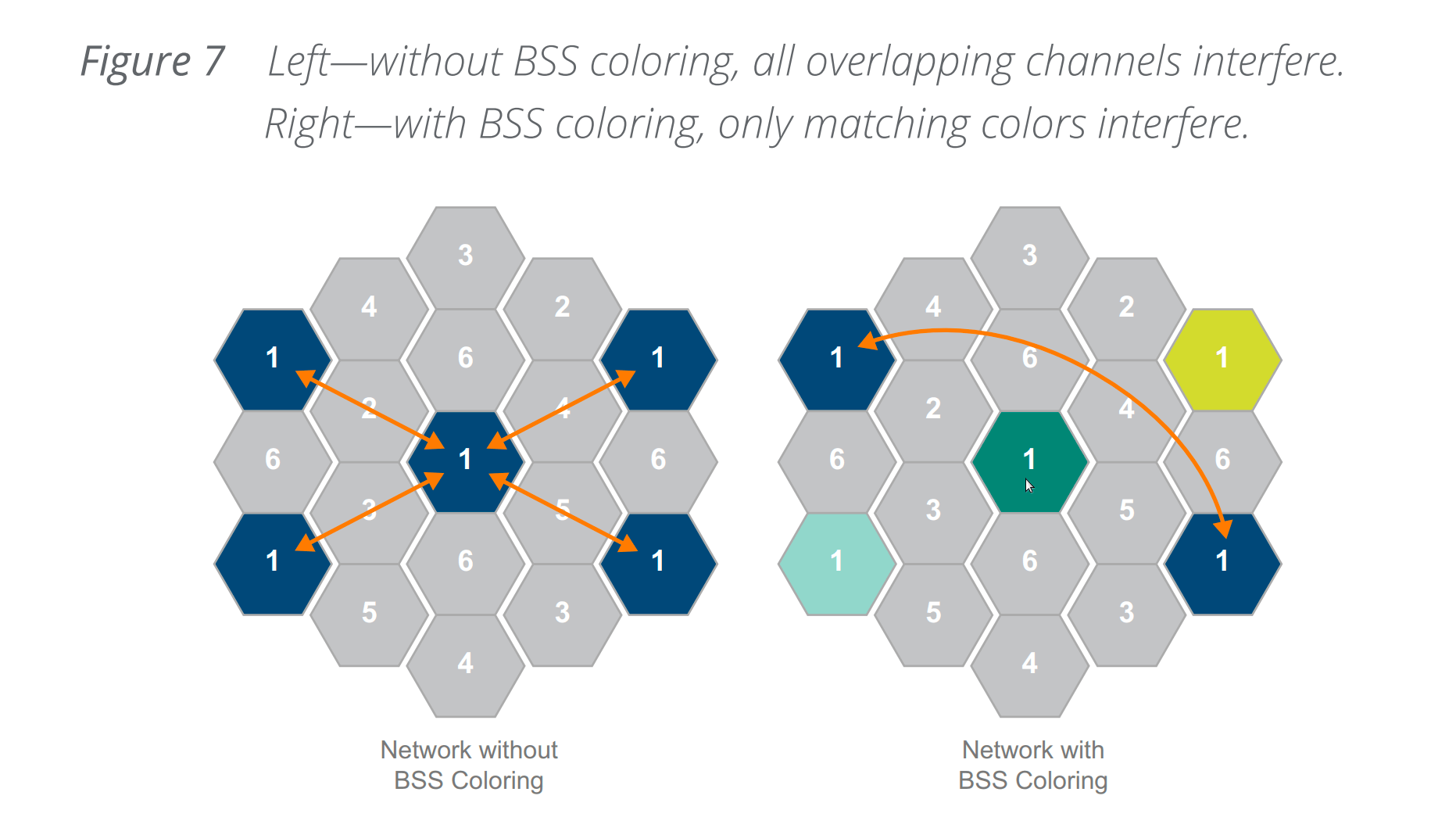
Beamforming - Exists on Wi-Fi 5, though that standard supports four antennas and Wi-Fi 6 increases this to eight. Beamforming improves data rates and extends range by directing signals toward specific clients instead of in every direction at once. This aids MU-MIMO, which doesn't work well with rapidly moving devices. Beamforming was optionally available on Wi-Fi 4 devices but became necessary with the implementation of MU-MIMO on Wi-Fi 5 Wave 2. By carefully controlling transmissions from several antennas, we can cause their signals to interfere on purpose and redirect the resulting signal in a new direction.
TWT (Target Wake Time) - Wake-time scheduling instead of contention-based access. A router can tell a client when to sleep and when to wake, which is expected to make a considerable difference in battery life since a device will know when to listen on a channel.

Uplink resource scheduler - Similarly, instead of users competing to upload data as on older wireless networks, Wi-Fi 6 schedules uplinks to minimize conflicts, resulting in better resource management. Everybody gets their own slot to talk so nobody has to shout or talk over other people.
Trigger-based Random Access - Also reduces data collisions/conflicts by specifying the length of an uplink window among other attributes that improve resource allocation and boost efficiency.
Two NAVs (Network Allocation Vector) - When a wireless station is transmitting, it advertises the duration it will take to complete so other stations can set their NAV to avoid conflicts when accessing the wireless medium. Wi-Fi 6 introduces two NAVs: One for the network that the station belongs to and one for neighboring networks. This should also reduce energy consumption by minimizing the need for carrier sensing.
Improved outdoor operation - Several of these features will result in better outdoor performance, including a new packet format, longer guard intervals and modes for improved redundancy and error recovery.
Wi-Fi 6E: Expanding Wi-Fi 6 to Include 6GHz
Wi-Fi 6E is the name of a new extension to the existing Wi-Fi 6 standard to signify it's capable of supporting all-new 6 GHz frequencies. This will add more spectrum, higher throughputs, and lower latency.
Industry leaders such as Qualcomm determined that adequate quality of service on future networks will require more spectrum than either 2.4GHz or 5GHz can provide. The 2.4GHz band has long been saturated by common electronics such as microwaves. The other option, 5GHz, has insufficient spectrum for wider bandwidth channels (such as 80MHz or 160MHz) and portions of 5GHz are subject to restrictions that limit its use.
In early 2020, the FCC gave official approval for Wi-Fi to extend its reach to an enormous swath of new radio spectrum in the 6 GHz band in the US. Specifically, the new Wi-Fi 6E standard will have access to 1.2 GHz, or 1,200 MHz of radio spectrum, ranging from 5.9 GHz to 7.1 GHz (and incorporating all the 6 GHz frequencies in between, hence the 6 GHz references).
Standard Wi-Fi is facing a spectrum shortage because if the increasing number of devices being used around the world and the addition of 6GHz will help mitigate this problem. Once allowed, 6GHz will facilitate continued Wi-Fi growth, as well as other advantages such as broader channel sizes and less interference from legacy Wi-Fi 4 (802.11n) and Wi-Fi 5 devices. Analysts predict approval will trigger the quick adoption of the band by equipment manufacturers.
To put the new spectrum in perspective, even the widest connections for millimeter wave 5G---the fastest kind of 5G connection available---are limited to 800 MHz. In other words, the new Wi-Fi connections have access to nearly 1.5 times the amount of frequencies to transmit on as the fastest 5G connections.
Theoretically, that means that Wi-Fi 6E connection speeds could prove to be significantly faster than even the best that 5G has to offer. Plus, because of the basic laws of physics and signal propagation, Wi-Fi 6E coverage can actually be wider than millimeter wave 5G.
The impact of Wi-Fi 6E will truly shine in highly congested areas. Routers will have wider channels to work with to accommodate more devices at higher throughput rates.
Wi-Fi 6 or 802.11ax is only one of many upcoming wireless standards being developed to service the variety of network demands that will be made by different types of devices. 802.11ad/ay will bring multi-gigabit speeds through the use of millimeter wave frequencies. On the opposite end of the spectrum, 802.11ah is designed for ultra low-power and could result in battery life of several years.
Wrap Up: A Sky-Level View of Wi-Fi 6
Meant to replace both 802.11n and 802.11ac as the next WLAN standard, 802.11ax or Wi-Fi 6 will deliver considerable increases in network efficiency and capacity for dense population centers, with moderate improvements to peak data rates, which will be sustained better across more devices at once.
Or as Qualcomm likes to put it, "the problem isn't how fast Wi-Fi can go, but if the Wi-Fi network has enough capacity to handle the growing demand for many different connected devices and services."
There aren't currently many Wi-Fi 6 clients, so the adoption will take a while. The improvements in this generation won't really be felt until a larger portion of devices uses the standard. As usual, Wi-Fi 6 is backwards compatible, but older devices won't be able to take advantage of the newer features.
Contemplating Wi-Fi 6 more broadly, the boost in multi-user support and particularly the increase in simultaneous upstream connections are arriving alongside an accelerating demand for user data. This data will be gathered from IoT devices and used for purposes such as machine learning, fueling artificial intelligence, the future of technology as a whole and a growing digital economy.
As mentioned in the introduction of this article, routers are already available based on draft 802.11ax specifications. We're currently working on an updated mesh roundup featuring the newest Wi-Fi 6 devices, so stay tuned for that.



